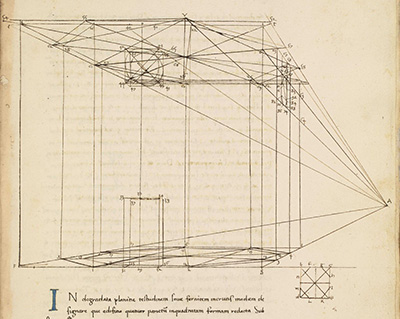Piero Della Francesca is regarded as one of the most genuine men of the renaissance. Pierro had a passion for art and geometry, but in this bit, we will focus on geometry. We will also try to focus on how he integrated his love for geometry in his artistic work.
Luca Pacioli was also a renowned mathematician, a great lecturer, a prolific author, a teacher, a religious mystic, and a scholar in a wide range of fields. He is one of the individuals who benefitted from Piero’s great passion for geometry.
Since Piero Della Francesca has two passions, he linked them between the organic and geometric basis of beauty. This is what Kenneth Clark termed as the philosopher's stone of aesthetics. Piero is known as one of the greatest practitioners of linear perspective. He even authored a book on linear perspective. The book is called De Prospectiva Pingendi, which was the first of the three books he wrote. The other two books are called De Quinque Corporibus Regularibus and Trattato del Abaco.
As mentioned earlier, Piero had a way of using geometry in his paintings. A good example is the flagellation of Christ. Here is what he said about the painting, "no picture could exude a more pronounced air of geometric, and no painting was ever more scrupulously planned." This is one of the paintings that have consumed the most time to analyze. The painting measures 81,500mm by 59,000 mm.
If the orthogonal is extended to find the vanishing point, it doesn’t seem to fall on any point that is essential to the story. Piero Della Francesca retrieves his clue from the dimensions of the paintings; one braccio 58.4cm by 81.5 cm, leading to the ration of the sides = 1.40 ~ 21/2. If arc EB is swung from A, it leads to the square ASED. Therefore, the width of the panting is equal to the diagonal of the square. This further confirms that the square is a root-two rectangle.
The Diagonal AE in the square goes through V, which is the vanishing point of perspective. Moreover, in the square ATVK it is clear that arc KT from A cuts through the diagonal at Christ’s head, which is halfway up the painting.
The Tile Patterns
The drawing of Christ stands in a green circle which is inscribed in a square. This is best described as squaring the circle. It can be deduced that the tile pattern which is inside the praetorium is quite complicated and based on the diagonals of the primary square, an irrational figure such as the one found on the proportions of the frame. The pattern of the tile, which is outside the praetorium is simple squares. This tends to lead to two separate zones: the space on the inside, which is occupied by Christ, and the simple world on the outside. These are complicated things that can only be done by the likes of Piero Della Francesca.
The tiles located on the inside of the praetorium leads to an octagonal pattern. Piero Della Francesca was trying to speak about the resurrection and baptism, as depicted by the translation of the pattern. This makes sense because Jesus resurrected from the tomb, eight days after entering Jerusalem.
Piero's Paintings
Most paintings done by Piero Della Francesca were inspired by his deeply rooted interest in geometry. Therefore, he used each pint of the paintings to manifest his love for geometry. Square format arrest motion, which is one of his paintings, has a square format that makes a scene static and solemn. In this drawing, the square format improves the story of adoration to a solemn group portrait. The next drawing by Piero Della Francesca is known as the resurrection of Christ. Even in this case, it is clear to see much Piero Della Francesca is used to the square format. This painting is mostly square and at least 10% higher than its width.
With the square format, Piero Della Francesca achieves a mood of stillness. The static quality is achieved by placing Christ in the centre of the square. According to analysts, the placement of Christ at the centre gives him a unique frontal symmetry that makes him look more like a statue. About the vertical zones: the central vertical further divides the scene with winter falling on the left and summer on the right. The rebirth nature of this drawing depicts the rebirth of Christ.
Final Thought
Piero Della Francesca had a unique way of including his love for mathematics in his drawings. This made him one of the greatest artists of the ancient times for which he receives accolades to date. Piero did a lot more drawings, and each time he did, he brought in some aspects of geometry to communicate important messages to the audience.




